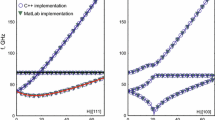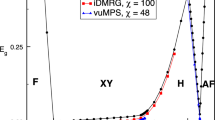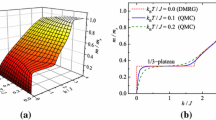Abstract
This chapter gives the mathematical details of the calculation of the ground state energy of the spin-1/2 linear chain with antiferromagnetic nearest neighbour exchange. Although the form of the ground-state wave function had been given by Bethe using the Bethe Ansatz, as described in the previous chapter, it was several years before Hulthén was able to use it to calculate the ground-state energy. The procedure involves setting up an integral equation for a function f. Although f does not have a simple physical significance, the complete wave function is made up of a superposition of phase-shifted plane waves with wave vector k. f is related to the rate of change of the density of the distribution k. Once the fundamental integral equation has been derived it is solved by Fourier transform. Finally the solution f is used to find the antiferromagnetic ground-state energy.
Access provided by Autonomous University of Puebla. Download chapter PDF
Similar content being viewed by others
4.1 The Fundamental Integral Equation
Although Bethe had given the wave functions in 1931 they were in a rather difficult formal form, involving sums over permutations. The first really useful result based on Bethe’s work was by Hulthén in 1938 [1].
As we saw for two spins, if J is −ve, then the ground state is ferromagnetic and completely aligned. This state is also very simple from a quantum mechanical point of view as the eigenstate is one of the basis states. However, for J +ve the ground state is antiferromagnetic and even for two spins is more complicated.
When we considered states with two deviation from the aligned state in the N atom chain we found two types of states
-
a.
2 ‘free’ deviations
-
b.
bound pair.
If J is positive the bound states lie above the free ones in energy, so the lowest state is the class C type for which k 1, k 2 and \(\phi _{12}\) are all real. These are states for which \(|\lambda _1-\lambda _2|\geq 2\). For r deviations the same result applies. The lowest states are those for which all the k i and \(\phi_{ij}\) are real. Again these are class C type and have \(|\lambda_i - \lambda_j| \geq 2\) for all i, j.
The classical antiferromagnetic ground state is (choosing the direction of alignment of the spins to be parallel and antiparallel to the z-axis)
which is a state with \(\frac{N}{2}\) atoms reversed. The corresponding quantum mechanical state, known as the Néel state,
is a basis state but is not an eigenstate. Nevertheless the true ground state will not be orthogonal to this state and since it is a state with \(S_T^Z = 0\), i.e. \(r = \frac{N}{2}\), then the ground state will have \(S_T^z = 0\) and \(r = \frac{N}{2}\) also.
The equations we need to solve are
and
Clearly \(\lambda_i + N\) is equivalent to λ i (since adding N to λ i merely increases k i by 2π). Hence we can restrict λ i to be an integer in the range \(0 \leq \lambda_i \leq N-1\) without loss of generality. The antiferromagnetic ground state has \(r = \frac{N}{2}\), i.e. \(\frac{N}{2}\) values of λ i , and is class C so we require \(|\lambda_i - \lambda_j| \geq 2\) for all i, j. There are two possible choices:
The first of these has \(\lambda_1 = 0\) and it can be shown that this gives a state in which S T = 1 with \(S_T^Z = 0\), while the second choice gives a state with \(S_T = 0\) and \(S_T^Z = 0\). The second of these is the correct one since the first is degenerate with other states with \(S_T = 1\) and \(S_T^Z = \pm 1\) which lie higher in energy.
Now because the λ i are uniformly spaced, we can introduce a new variable
which becomes a continuous variable in the limit \(N \rightarrow \infty\), running from 0 to 1. Likewise we can regard the k i as forming a continuous set, i.e.
In Eq. (4.2) we have k j as well as k i . k j is associated with λ j and we introduce
so that Eq. (4.2) becomes
and we shall restrict φ to lie in the range \(-\pi \leq \phi \leq \pi \). Note that the y here is not the same as the y in the previous chapter.
Equation (4.1) becomes
(the factor \(\frac 12\) comes because the λ j are separated by 2). Note that the range of \(k(x)\) is \(0\leq k(x)\leq 2\pi \), unlike that of φ. It can be shown that if \(x <y\) then \(k(x) <k(y)\) as one would expect from Eq. (4.4) provided the integral is well-behaved.
These are the integral equations solved by Huthén. The treatment given here is based on that of Mattis [2] with important extra details. First make the substitutions
so that \(2\cot \frac{1}{2} \, \phi(x,y) = \xi(x) - \eta(y)\).
When \(x=y\), \(\cot \frac 12\phi =0\), so \(\phi =\pm \pi \) and at this point the value of φ jumps from −π to π. For this reason we divide the integral in (4.4) into two sections:
In the first integral \(y<x\) therefore \(k(y)<k(x)\). This implies, as shown in Fig. 4.1, and recalling that \(0\leq k(x)\), \(k(y)\leq 2\pi \), that \(\cot \frac{k(y)}{2} > \cot \frac{k(x)}{2}\) and therefore
As shown in Fig. 4.1, if \(\cot \frac{\phi}{2} < 0\) and \(-\pi \leq \phi \leq \pi\) we must have \(\phi < 0\). Similarly in the second integral we have \(\phi > 0\).
Now differentiate (4.5) with respect to x
so
Next we introduce the functions
then
This is now an integral over η instead of y. As y goes from 0 to 1, k(y) goes from 0 to 2π (not proved here but can be shown from (4.4)) so \(\cot \frac{k(y)}{2}\) goes from +∞ to −∞. Therefore
Finally \(\dfrac{dk}{dx} = \dfrac{dk}{d\xi } \dfrac{d\xi }{dx} = -\dfrac 1{f(\xi )} \dfrac{dk}{d\xi }\) and since \(\xi = \cot \dfrac{k(x)}2\), \(k(x) = 2\cot^{-1}\xi\) and \(\dfrac{dk}{d\xi } = \dfrac{-2}{1+\xi ^2}\). Therefore
This is the fundamental integral equation for f(ξ) (see, Mattis [2] 5.168).
4.2 Solution of the Fundamental Integral Equation
Linear integral equations in which the kernel is a function of \((\xi -\eta )\) only, can be solved by the Fourier Transform. We define
with inverse
Substituting in Eq. (4.6) gives
Now
so substituting \(z = \dfrac{1}{2}(\xi-\eta)\), with \(d\eta = -2dz\), gives
Therefore
Multiply both sides by \(e^{iq^{\prime }\xi }\) and integrate \(\int_{-\infty }^\infty d\xi \)
Finally
4.3 The Ground State Energy
We can now calculate the ground state energy of the infinite chain. For a finite chain with N atoms we have seen that the ground state energy is given by
In the limit \(N \rightarrow \infty\) we again make the changes
so that
Therefore
Doing the ξ integral
Therefore
This is a very famous result due to Hulthén and Bethe. It is one of the outstanding achievements of modern theoretical physics.
As well as this exact result for the ground state energy of the spin-\(\frac{1}{2}\) chain with isotropic Heisenberg exchange, the Bethe Ansatz [3] has been used to obtain many other results for spin-\(\frac{1}{2}\) chains. Some of these are as follows:
-
a.
It may be extended to the case of anisotropic exchange. Firstly to the XXZ-model in which S x S x and S y S y terms are equal but the S z S z terms are different, by Orbach [4] and Walker [5] and later to the more general XYZ-model in which all three terms are different, by Baxter [6].
-
b.
For the XXZ-model the correlation functions behave as
$$\left|\Big\langle S_i^z S_{i+R}^z \Big\rangle\right| = \mathrm{const.} \mathrm{as} R \rightarrow \infty$$for the anisotropic model (\(\varDelta>1\)) and
$$\left|\Big\langle S_i^z S_{i+R}^z \Big\rangle\right| \propto \frac{1}{R} {\textrm as} R \rightarrow \infty$$for the isotropic model (\(\varDelta=1\)) showing that there is no long range order for \(\varDelta = 1\). These and other important results for the correlation function of this model were obtained by a completely different method, the inverse scattering method, by Bogoliubov et al. [7]
-
c.
It was extended to include the effects of a magnetic field by Griffiths [8]
-
d.
Results for the elementary excitations (antiferromagnetic magnons) can be found as described in the next chapter.
-
e.
The thermodynamics, i.e. the properties at non-zero temperature, have been studied by Yang and Yang [9–11], Takahashi and Suzuki [12], Gaudin [13] and Klümper [14]
References
Hulthen, L.: Ark. Mater. Astron. Fys. A 26, 11–116 (1938)
Mattis, D.C.: The Theory of Magnetism I, Springer, Berlin (1981, 1988)
Bethe, H.A.: Z. Phys. 71, 205–226 (1931)
Orbach, R.: Phys. Rev. 112, 309–316 (1958)
Walker, L.R.: Phys. Rev. 116, 1089–1090 (1959)
Baxter, R.J.: Ann. Phys. (New York) 70, 323–337 (1972)
Bogoliubov, N.M., Izergin, A.G., Korepin, V.E.: Nucl. Phys. B275, 687–705 (1986)
Griffiths, R.B.: Phys. Rev. 133, A768–A775 (1964)
Yang, C.N., Yang, C.P.: Phys. Rev. 150, 321–327 (1966)
Yang, C.N., Yang, C.P.: Phys. Rev. 150, 327–339 (1966)
Yang, C.N., Yang, C.P.: Phys. Rev. 151, 258–264 (1966)
Takahashi, M., Suzuki, M.: Prog. Theor. Phys. 48, 2187–2209 (1972)
Gaudin, M.: Phys. Rev. Lett. 26, 1301–1304 (1971)
Klümper, A.: Europhys. Lett. 9, 815–820 (1989)
Author information
Authors and Affiliations
Corresponding author
Rights and permissions
Copyright information
© 2010 Springer-Verlag Berlin Heidelberg
About this chapter
Cite this chapter
Parkinson, J.B., Farnell, D.J. (2010). The Antiferromagnetic Ground State. In: An Introduction to Quantum Spin Systems. Lecture Notes in Physics, vol 816. Springer, Berlin, Heidelberg. https://doi.org/10.1007/978-3-642-13290-2_4
Download citation
DOI: https://doi.org/10.1007/978-3-642-13290-2_4
Published:
Publisher Name: Springer, Berlin, Heidelberg
Print ISBN: 978-3-642-13289-6
Online ISBN: 978-3-642-13290-2
eBook Packages: Physics and AstronomyPhysics and Astronomy (R0)





